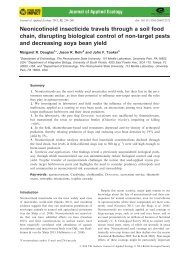Jones-et-al-2014
Jones-et-al-2014
Jones-et-al-2014
Create successful ePaper yourself
Turn your PDF publications into a flip-book with our unique Google optimized e-Paper software.
1. Rortais A, Arnold G, H<strong>al</strong>m MP and Touff<strong>et</strong>-Briens F, Modes of honeybees exposure to<br />
systemic insecticides: estimated amounts of contaminated pollen and nectar consumed by<br />
different categories of bees. Apidologie (Celle) 36:71-83 (2005).<br />
2. Blacquiere T, Smagghe G, van Gestel CAM and Mommaerts V, Neonicotinoids in bees: a<br />
review on concentrations, side-effects and risk assessment. Ecotoxicology 21:973-992<br />
(2012).<br />
3. Schneider CW, Tautz J, Grünew<strong>al</strong>d B and Fuchs S, RFID tracking of subl<strong>et</strong>h<strong>al</strong> effects of<br />
two neonicotinoid insecticides on the foraging behavior of Apis mellifera. PLoS ONE 7,<br />
e30023. (2012).<br />
4. Henry M, Beguin M, Requier F, RollinO, Odoux J-F, Aupinel P, Aptel J, Tchamitchian S<br />
and Decourtye A, A common pesticide decreases foraging success and surviv<strong>al</strong> in honey<br />
bees. Science 336:348–350 (2012).<br />
5. Gill RJ, Ramos-Rodriguez O and Raine NE, Combined pesticide exposure severely<br />
affects individu<strong>al</strong>- and colony-level traits in bees. Nature 491:105-119. (2012).<br />
6. Whitehorn PR, O’Connor S, Wackers FL and Goulson D, Neonicotinoid pesticide<br />
reduces bumble bee colony growth and queen production. Science 336:351–352 (2012).<br />
7. European Food Saf<strong>et</strong>y Authority; Conclusion on the peer review of the pesticide risk<br />
assessment for bees for the active substance clothianidin. EFSA Journ<strong>al</strong> 11:3066 (2013).<br />
8. European Food Saf<strong>et</strong>y Authority; Conclusion on the peer review of the pesticide risk<br />
assessment for bees for the active substance thiam<strong>et</strong>hoxam. EFSA Journ<strong>al</strong> 11:3067.<br />
(2013).<br />
9. European Food Saf<strong>et</strong>y Authority; Conclusion on the peer review of the pesticide risk<br />
assessment for bees for the active substance imidacloprid. EFSA Journ<strong>al</strong> 11:3068 (2013).<br />
10. US Environment<strong>al</strong> Protection Agency, Office of Pesticide Programs. Factshe<strong>et</strong><br />
Clothianidin (2003) EPA Publication 7501C;<br />
www.epa.gov/opp00001/chem_search/reg_actions/registration/fs_PC-044309_30-May-<br />
03.pdf.<br />
11. Goulson D, An overview of the environment<strong>al</strong> risk posed by neonicotinoids insecticides.<br />
J Apply Ecol DOI: 10.1111/1365-2664.12111 (2013).<br />
12. Krupke CH, Hunt GJ, Eitzer BD, Andino G and Given K, Multiple Routes of Pesticide<br />
Exposure for Honey Bees Living Near Agricultur<strong>al</strong> Fields. PLoS ONE 7, e29268. (2012).<br />
13. Schmuck R, Schoning R, Stork A and Schramel O, Risk posed to honeybees (Apis<br />
mellifera L. Hymenoptera) by an imidacloprid seed dressing of sunflowers. Pest Manag<br />
Sci 57:225–238 (2001).<br />
14. Bonmartin JM, Moineau I, Charv<strong>et</strong> R, Collin ME, Fleche C and Bengsch ER, Behavior<br />
of imidacloprid in fields. Toxicity for honey bees. Environment<strong>al</strong> Chemistry: Green<br />
Chemistry and Pollutants in Ecosystems, ed by Lichfourse E, Scwarzbauer J and Robert<br />
D, Springer, New York, pp. 483-494 (2005).<br />
15. European Food Saf<strong>et</strong>y Authority; Conclusion on the peer review of the pesticide risk<br />
assessment of the active substance imidacloprid. EFSA Scientific Report 148 (2008)<br />
This article is protected by copyright. All rights reserved




